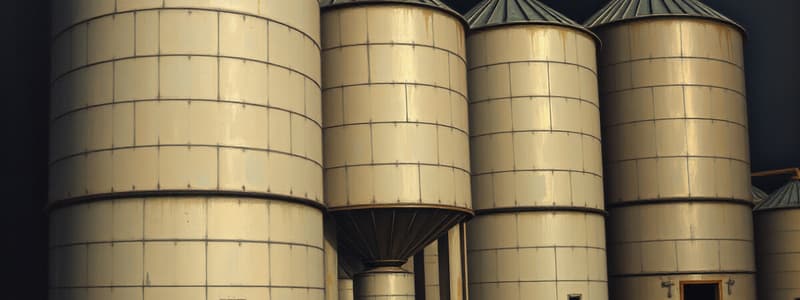Podcast
Questions and Answers
What is one of the strengths of traditional storage structures?
What is one of the strengths of traditional storage structures?
- Long-term durability
- Utilization of farm waste (correct)
- High capacity for storage
- Ability to withstand harsh weather
Which of the following is a weakness of traditional storage structures?
Which of the following is a weakness of traditional storage structures?
- High maintenance costs
- Temporary nature and less capacity (correct)
- Requires high-tech materials
- Designed for urban use only
What opportunity does improving construction with technical support offer?
What opportunity does improving construction with technical support offer?
- Enhanced employability of rural youth (correct)
- Restricting the use of farm materials
- Need for expensive materials
- Increased reliance on external markets
What is a significant threat faced by traditional storage structures?
What is a significant threat faced by traditional storage structures?
What is the typical storage capacity range of improved storage structures?
What is the typical storage capacity range of improved storage structures?
What material is primarily used to make the Pusa Bin moisture proof?
What material is primarily used to make the Pusa Bin moisture proof?
Which component is NOT part of the construction of the Pusa Bin?
Which component is NOT part of the construction of the Pusa Bin?
Why are improved storage structures generally preferred over traditional ones?
Why are improved storage structures generally preferred over traditional ones?
What aspect of rural youth's employability is enhanced with better storage construction techniques?
What aspect of rural youth's employability is enhanced with better storage construction techniques?
In what way do traditional storage structures primarily benefit farmers?
In what way do traditional storage structures primarily benefit farmers?
Flashcards are hidden until you start studying
Study Notes
Modern Storage Structures
- Reflective external surfaces, insulation, and sunshades help control internal temperatures.
- Modern storage facilities include silo-type and shed-type structures.
- Silos, typically circular with conical bottoms, are constructed from steel or reinforced concrete.
Silo Type Storage
- Silos are commonly used for bulk storage of grains and can also store liquid foods (e.g., milk, oil).
- Materials for bulk storage bins vary (e.g., mild steel, fiberglass, brick), with mild steel and reinforced concrete commonly used in India.
- Key advantages of modern storage bins include:
- Cost-effectiveness and simplified handling
- Reduced space requirements
- Elimination of bag costs
- Automation and mechanization for efficient handling and product quality
- Protection against pest losses (birds and rodents)
- Silos are classified as deep or shallow based on the relative dimensions of depth to diameter.
Design Terminology
- The "plane of rupture" is the surface along which materials start sliding, determined by the bin's design.
- Example of a storage bag: dimensions 100 cm (length) x 60 cm (width) x 30 cm (height), with a storage capacity of 93 kg of Wheat and 75 kg of Paddy.
Metal Bins
- Steel, aluminum, and reinforced concrete bins provide moisture and fire resistance, leading to greater durability.
- Available capacities range from 50 kg to 10 tonnes, manufactured on a commercial scale.
Requirements for Ideal Storage Structures
- Must be easy to clean and provide protection from rodents and birds.
- Should mitigate temperature and humidity variations and facilitate periodical inspections.
- Pesticide application should be easy via fumigation or spraying.
- Designed for efficient transportation and reception of goods, with sealed openings to prevent contamination.
- Smooth internal surfaces without unnecessary cavities or projections.
- Adequate ventilation is essential to prevent moisture build-up, and materials used should be non-hygroscopic.
- Orientation should minimize solar radiation exposure.
SWOT Analysis of Traditional Storage Structures
- Strengths: Utilizes farm waste, low-cost, quick construction, independent ownership.
- Weaknesses: Low capacity, temporary, and vulnerable to adverse weather.
- Opportunities: Technical support can enhance construction quality, improving rural employment and revenues.
- Threats: Risk of fire, pests, and theft.
Improved Storage Structures
- Designed for long-term storage and higher capacity, ranging from 1.5 to 150 tonnes.
- It's utilized in various regions via bulk and bag storage methods.
- Example: Pusa Bin made from mud, featuring moisture-proof plastic lining and reinforced walls with mud plaster.
- Construction of Pusa Bin involves a mud brick platform, plastic sheeting, and kachcha bricks to secure the structure against moisture.
Studying That Suits You
Use AI to generate personalized quizzes and flashcards to suit your learning preferences.




